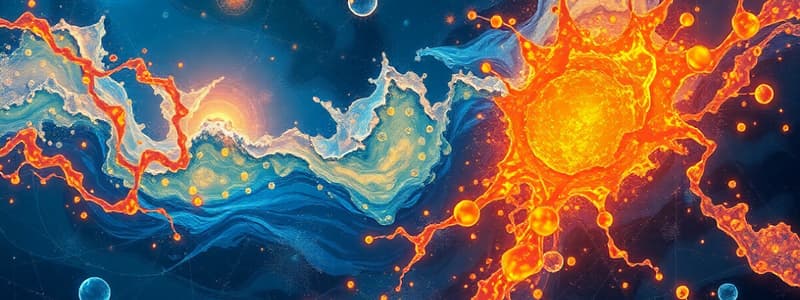Podcast
Questions and Answers
Which metal is the least reactive according to the reactivity series?
Which metal is the least reactive according to the reactivity series?
- Copper (Cu) (correct)
- Potassium (K)
- Aluminium (Al)
- Iron (Fe)
What property do metals generally NOT possess?
What property do metals generally NOT possess?
- Poor electrical conductivity (correct)
- High density
- Malleability
- High melting and boiling points
Which of the following is a characteristic chemical property of metals?
Which of the following is a characteristic chemical property of metals?
- They form metal oxides when reacting with oxygen. (correct)
- They gain electrons to form cations.
- They typically float on water.
- They do not react with acids.
Which metal is likely to react vigorously with water?
Which metal is likely to react vigorously with water?
What is the general appearance of non-metals?
What is the general appearance of non-metals?
Which of the following statements about the electropositivity of metals is correct?
Which of the following statements about the electropositivity of metals is correct?
Which metal is commonly used in electronics due to its low reactivity?
Which metal is commonly used in electronics due to its low reactivity?
Which characteristic is true for both metals and non-metals?
Which characteristic is true for both metals and non-metals?
What kind of oxides do non-metals typically form when reacting with oxygen?
What kind of oxides do non-metals typically form when reacting with oxygen?
What describes the malleability of non-metals?
What describes the malleability of non-metals?
Flashcards are hidden until you start studying
Study Notes
Reactivity Series
- Definition: A series of metals arranged in order of decreasing reactivity.
- Common Metals in the Series:
- Potassium (K)
- Sodium (Na)
- Calcium (Ca)
- Magnesium (Mg)
- Aluminium (Al)
- Zinc (Zn)
- Iron (Fe)
- Lead (Pb)
- Copper (Cu)
- Silver (Ag)
- Gold (Au)
- Trends:
- Alkali metals (e.g., K, Na) are highly reactive, especially with water.
- Transition metals (e.g., Cu, Ag, Au) are less reactive and often used in jewelry and electronics.
- Applications:
- Helps predict reactions, such as displacement reactions.
- Utilized in mining and extraction processes.
Physical Properties
-
Metals:
- Luster: Shiny appearance.
- Conductivity: Good conductors of heat and electricity.
- Malleability: Can be hammered or rolled into thin sheets.
- Ductility: Can be drawn into wires.
- Density: Generally have high density.
- Melting/Boiling Points: Usually high.
-
Non-Metals:
- Luster: Dull appearance.
- Conductivity: Poor conductors of heat and electricity (insulators).
- Malleability/Ductility: Brittle in solid state; shatter rather than bend.
- Density: Generally have low density.
- Melting/Boiling Points: Varies widely; many are gases at room temperature.
Chemical Properties
-
Metals:
- Reactivity with Acids: React with acids to produce hydrogen gas and a salt.
- Reaction with Oxygen: Form metal oxides (e.g., rusting in iron).
- Corrosion: Susceptible to oxidation and corrosion.
- Electropositivity: Tend to lose electrons and form positive ions (cations).
-
Non-Metals:
- Reactivity with Acids: Generally do not react with acids.
- Reaction with Oxygen: Form non-metal oxides (e.g., CO₂, SO₂).
- Hydrogen Halides: React with halogens to form acids (e.g., HCl).
- Electronegativity: Tend to gain electrons and form negative ions (anions).
Reactivity Series
- A list of metals ranked by how easily they react with other substances.
- The most reactive metals are at the top, such as potassium (K) and sodium (Na).
- Gold (Au) and silver (Ag) are among the least reactive.
- This series is helpful in predicting how metals will behave in different chemical reactions, such as displacement reactions.
Physical Properties of Metals and Non-Metals
- Metals are known for being shiny, malleable (can be hammered into sheets), ductile (can be pulled into wires), good conductors of heat and electricity, and generally have high density and melting/boiling points.
- Non-metals are typically dull, brittle, poor conductors of heat and electricity, have low density, and have varied melting and boiling points, with many being gases at room temperature.
Chemical Properties of Metals and Non-Metals
- Metals are reactive with acids, producing hydrogen gas and a salt.
- They react with oxygen to form metal oxides, leading to corrosion (e.g., rusting in iron).
- Metals tend to lose electrons and form positive ions (cations), a property called electropositivity.
- Non-metals generally do not react with acids.
- They react with oxygen to form non-metal oxides (e.g., carbon dioxide).
- Non-metals tend to gain electrons and form negative ions (anions), which is called electronegativity.
Studying That Suits You
Use AI to generate personalized quizzes and flashcards to suit your learning preferences.


